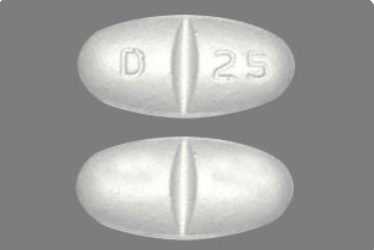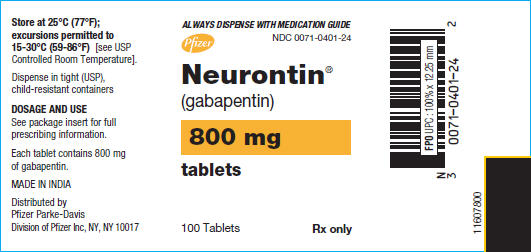What is Gabapentin ?
Gabapentin capsules, tablets, and oral solution are used along with other medications to help control certain types of seizures in people who have epilepsy.

Gabapentin capsules, tablets, and oral solution are also used to relieve the pain of postherpetic neuralgia (PHN; the burning, stabbing pain or aches that may last for months or years after an attack of shingles). Gabapentin extended-release tablets (Horizant) are used to treat restless legs syndrome (RLS; a condition that causes discomfort in the legs and a strong urge to move the legs, especially at night and when sitting or lying down). Gabapentin is in a class of medications called anticonvulsants. Gabapentin treats seizures by decreasing abnormal excitement in the brain. Gabapentin relieves the pain of PHN by changing the way the body senses pain. It is not known exactly how gabapentin works to treat restless legs syndrome.
Gabapentin is a medication primarily used to treat seizures and nerve pain. It belongs to a class of drugs known as anticonvulsants or antiepileptic drugs. Gabapentin works by affecting the neurotransmitters in the brain, specifically by modulating the activity of gamma-aminobutyric acid (GABA), a neurotransmitter that inhibits brain activity.
Here are some common uses of gabapentin:
-
- Epilepsy: Gabapentin is approved by the FDA (Food and Drug Administration) for the treatment of partial seizures in adults and children.
- Nerve Pain (Neuropathic Pain): Gabapentin is frequently prescribed off-label for various types of nerve pain, including diabetic neuropathy, postherpetic neuralgia (nerve pain caused by shingles), and neuropathic pain associated with conditions such as fibromyalgia.
- Restless Legs Syndrome (RLS): Gabapentin may be used off-label to alleviate symptoms of restless legs syndrome, a neurological disorder characterized by uncomfortable sensations in the legs and an irresistible urge to move them.
- Anxiety Disorders: In some cases, gabapentin may be prescribed off-label to manage anxiety disorders, particularly in individuals who experience anxiety as a component of their neurological conditions.
Gabapentin is usually taken orally, and the dosage depends on the condition being treated, the patient’s age, kidney function, and other factors. It is available in various formulations, including capsules, tablets, and an oral solution.
What is Gabapentin Approved for?
Gabapentin is used to:
- Prevent and control partial seizures. Gabapentin can be used in adults and children age 3 and older who have partial seizures.
- Relieve nerve pain following shingles in adults. Shingles is a painful rash that develops many years after you’ve had chickenpox. The virus that causes chickenpox stays dormant in a portion of your spinal nerve root called the dorsal root ganglion. For whatever reason, this otherwise dormant virus gets reactivated — usually by stress — causing a shingles rash. Nerve pain following a case of shingles is called postherpetic neuralgia (PHN).
- Treat moderate-too-severe primary restless legs syndrome.
The branded gabapentin products Neurontin and Gralise are approved for partial seizures and PHN. The branded gabapentin enacarbil product Horizant is approved for restless legs syndrome and PHN.
Buy The Cheapest Gabapentin
Gabapentin is used with other medications to prevent and control seizures. It is also used to relieve nerve pain following shingles (a painful rash due to herpes zoster infection) in adults. Gabapentin is known as an anticonvulsant or antiepileptic drug.
OTHER USES: This section contains uses of this drug that are not listed in the approved professional labeling for the drug but that may be prescribed by your health care professional. Use this drug for a condition that is listed in this section only if it has been so prescribed by your health care professional.
 Gabapentin may also be used to treat other nerve pain conditions (such as diabetic neuropathy, peripheral neuropathy, trigeminal neuralgia) and restless legs syndrome.
Gabapentin may also be used to treat other nerve pain conditions (such as diabetic neuropathy, peripheral neuropathy, trigeminal neuralgia) and restless legs syndrome.
Gabapentin is an anti-epileptic medication, also called an anticonvulsant. It affects chemicals and nerves in the body that are involved in the cause of seizures and some types of pain.
Gabapentin is used in adults to treat nerve pain caused by herpes virus or shingles (herpes zoster).
The Horizant brand is also used to treat restless legs syndrome (RLS).
The Neurontin brand is also used to treat seizures in adults and children who are at least 3 years old.
Use only the brand and form of gabapentin that your doctor has prescribed. Check your medicine each time you get a refill at the pharmacy, to make sure you have received the correct form of this medication.
Gabapentin may also be used for purposes not listed in this medication guide.
What dosage strengths and forms does gabapentin come in?
Gabapentin is available as:
-
- Gabapentin tablets. It’s available as 300- and 600-milligram tablets (Gralise) and 600- and 800-milligram tablets (Neurontin or generic gabapentin).
- Gabapentin oral solution. The oral solution contains 250 millgrams of gabapentin per 5 milliliter (50 mg per mL) Neurontin or generic gabapentin.
- Gabapentin capsules. It’s available as 100-, 300- or 400-milligram gelatin capsules (Neurontin or generic gabapentin).
- Gabapentin enacarbil, 300- and 600-milligram extended-release tablets (Horizant).
How should I take gabapentin?
Take gabapentin exactly as prescribed by your doctor. Follow all directions on your prescription label. Do not take this medicine in larger or smaller amounts or for longer than recommended.
The Horizant brand of gabapentin should not be taken during the day. For best results, take Horizant with food at about 5:00 in the evening.
Both Gralise and Horizant should be taken with food.
Neurontin can be taken with or without food.
If you break a Neurontin tablet and take one half of it, take the other half at your next dose. Any tablet that has been broken should be used as soon as possible or within a few days.
Measure liquid medicine with a special dose-measuring spoon or medicine cup. If you do not have a dose-measuring device, ask your pharmacist for one.
If your doctor changes your brand, strength, or type of gabapentin, your dosage needs may change. Ask your pharmacist if you have any questions about the new brand you receive at the pharmacy.
Do not stop using gabapentin suddenly, even if you feel fine. Stopping suddenly may cause increased seizures. Follow your doctor’s instructions about tapering your dose.
Wear a medical alert tag or carry an ID card stating that you take gabapentin. Any medical care provider who treats you should know that you take seizure medication.
This medication can cause you to have a false positive urine protein screening test. If you provide a urine sample for testing, tell the laboratory staff that you are taking gabapentin.
Store at room temperature away from light and moisture.
Store the liquid medicine in the refrigerator. Do not freeze.
Gabapentin side effects
Get emergency medical help if you have any of these signs of an allergic reaction to gabapentin: hives; fever; swollen glands; painful sores in or around your eyes or mouth; difficulty breathing; swelling of your face, lips, tongue, or throat.
Report any new or worsening symptoms to your doctor, such as: mood or behavior changes, anxiety, depression, or if you feel agitated, hostile, restless, hyperactive (mentally or physically), or have thoughts about suicide or hurting yourself.
Call your doctor at once if you have:
-
- increased seizures;
- fever, swollen glands, body aches, flu symptoms;
- skin rash, easy bruising or bleeding, severe tingling, numbness, pain, muscle weakness;
- upper stomach pain, loss of appetite, dark urine, jaundice (yellowing of the skin or eyes);
- chest pain, irregular heart rhythm, feeling short of breath;
- confusion, nausea and vomiting, swelling, rapid weight gain, urinating less than usual or not at all;
- new or worsening cough, fever, trouble breathing;
- rapid back and forth movement of your eyes; or
- severe skin reaction — fever, sore throat, swelling in your face or tongue, burning in your eyes, skin pain, followed by a red or purple skin rash that spreads (especially in the face or upper body) and causes blistering and peeling.
Some side effects are more likely in children taking gabapentin. Contact your doctor if the child taking this medication has any of the following side effects:
-
- changes in behavior;
- memory problems;
- trouble concentrating; or
- acting restless, hostile, or aggressive.
Common gabapentin side effects may include:
-
- dizziness, drowsiness;
- dry mouth, blurred vision;
- headache;
- diarrhea; or
- swelling in your hands or feet.
This is not a complete list of side effects and others may occur. Call your doctor for medical advice about side effects. You may report side effects to FDA at 1-800-FDA-1088.
For more gabapentin inormation, please go to http://www.rxlist.com/neurontin-drug.htm
What are the serious side effects of gabapentin?
If you have any of these symptoms, call your healthcare provider right away:
- Signs of an allergic reaction: If you have a skin rash, hives, itching or swollen, blistered or peeling skin with or without fever contact your healthcare provider. You should also contact your provider if you have trouble breathing or swallowing, wheezing or swelling of your face, lips, throat, eyes, mouth or tongue
- Changes in mood or behavior: Call your provider for any suicidal thoughts or thoughts about dying, suicide attempts, new or worsening depression, anxiety, irritability or feelings of agitation or restlessness. You should also call your provider for trouble sleeping, panic attacks, feelings of aggression or anger, impulsive behavior, extreme increase in activity or talking and other changes in mood or behavior, confusion, inability to focus or memory problems as these can be side effects of your medication.
- Signs of liver abnormalities: Yellowing of your skin or whites of your eyes, dark urine, light-colored stools, vomiting, unusual bleeding or bruising.
- Signs of kidney abnormalities: Trouble urinating, a change in how much urine is passed, blood in your urine, or weight gain and swelling of legs and feet from retaining fluid.
- Other concerning abnormalities: Change in color of your skin to a bluish color on your lips, nail beds, fingers, or toes along with severe fatigue or weakness and unexpected muscle pain.
Are there any serious interactions with gabapentin and other medications?
Serious breathing problems can happen if you take gabapentin with drugs that cause severe sleepiness or decreased awareness. Some examples include narcotic opioids, anti-anxiety medicines, antidepressants, and antihistamines. If you are 65 years of age or older and/or have a condition that affects your lungs, such as chronic obstructive pulmonary disease (COPD), there is an increased risk for breathing problems. Watch for increased sleepiness or decreased breathing when you start taking gabapentin or when the dose is increased. Get help right away if you develop breathing problems.
Seek immediate medical attention if these symptoms develop:
- Confusion.
- Unusual dizziness or lightheadedness.
- Slowed, shallow or trouble breathing.
- Unresponsiveness (can’t wake up).
- Bluish-colored or tinted skin, especially on lips, fingers or toes.
What other medications and products can interact with gabapentin?
Products that interact with gabapentin include:
- Alcohol.
- Antihistamine-containing cold, cough and allergy products.
- Certain medicines for anxiety or sleep.
- Certain medicines for depression, such as amitriptyline, fluoxetine and sertraline.
- Certain medicines for seizures, such as phenobarbital and primidone.
- Certain medicines for stomach problems. (Wait two hours after taking aluminum and magnesium-containing antacids before taking gabapentin.)
- General anesthetics, local anesthetics, or muscle relaxants given before surgery.
- Narcotic pain medicines.
Can I drink alcohol while taking gabapentin?
Avoid drinking alcohol while taking gabapentin. Drinking alcohol with gabapentin could increase sleepiness or dizziness.
Can I take gabapentin if I’m pregnant or thinking of becoming pregnant?
It’s unknown if gabapentin can harm your unborn baby. For this reason, talk to your healthcare provider as soon as you know you are pregnant. You and your healthcare provider will determine if you should take gabapentin during your pregnancy or change to a different medication.

Does gabapentin pass into breast milk?
Yes, gabapentin does pass into breast milk. If you are breastfeeding or planning to breastfeed, talk with your healthcare provider about breastfeeding or medication options.
Is gabapentin a narcotic or controlled substance?
Gabapentin is not a narcotic. It’s not classified as a controlled substance in most states. (Kentucky, West Virginia, Michigan, Tennessee, and Virginia have reclassified gabapentin as a Schedule V controlled substance). Gabapentin is not an opioid.
Is gabapentin addictive?
Gabapentin is not addictive, but this doesn’t mean that gabapentin can’t be abused. A small number of studies have reported misuse and abuse of gabapentin.
Does gabapentin cause withdrawal symptoms?
Gabapentin withdrawal symptoms have been reported since the drug was approved. However, the individuals in these reports experienced symptoms after discontinuing higher-than-recommended doses of gabapentin and for uses for which the drug was not approved.
What’s known about gabapentin and overdose?
Overdoses on gabapentin have been reported. Individuals experienced double vision, slurred speech, drowsiness, diarrhea and sluggishness.
What should I do if I miss a dose of gabapentin?
If you forget to take a dose of gabapentin, take it as soon as you remember. If it’s just a few hours before it’s time to take your next dose, take only one dose. Never take more than one dose in an attempt to catch up. If you have any concerns or questions, be sure to call your healthcare provider or pharmacist right away.
